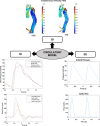Simulating impaired left ventricular-arterial coupling in aging and disease: a systematic review
- PMID: 38388416
- PMCID: PMC10885508
- DOI: 10.1186/s12938-024-01206-2
Simulating impaired left ventricular-arterial coupling in aging and disease: a systematic review
Abstract
Aortic stenosis, hypertension, and left ventricular hypertrophy often coexist in the elderly, causing a detrimental mismatch in coupling between the heart and vasculature known as ventricular-vascular (VA) coupling. Impaired left VA coupling, a critical aspect of cardiovascular dysfunction in aging and disease, poses significant challenges for optimal cardiovascular performance. This systematic review aims to assess the impact of simulating and studying this coupling through computational models. By conducting a comprehensive analysis of 34 relevant articles obtained from esteemed databases such as Web of Science, Scopus, and PubMed until July 14, 2022, we explore various modeling techniques and simulation approaches employed to unravel the complex mechanisms underlying this impairment. Our review highlights the essential role of computational models in providing detailed insights beyond clinical observations, enabling a deeper understanding of the cardiovascular system. By elucidating the existing models of the heart (3D, 2D, and 0D), cardiac valves, and blood vessels (3D, 1D, and 0D), as well as discussing mechanical boundary conditions, model parameterization and validation, coupling approaches, computer resources and diverse applications, we establish a comprehensive overview of the field. The descriptions as well as the pros and cons on the choices of different dimensionality in heart, valve, and circulation are provided. Crucially, we emphasize the significance of evaluating heart-vessel interaction in pathological conditions and propose future research directions, such as the development of fully coupled personalized multidimensional models, integration of deep learning techniques, and comprehensive assessment of confounding effects on biomarkers.
Keywords: Blood circulation; Computational modeling; Heart valve; Left ventricle; Ventricular−arterial coupling.
© 2024. The Author(s).
Conflict of interest statement
The authors declare that they have no competing interests.
Figures







Similar articles
-
Effects of aging on left ventricular-arterial coupling in man: assessment by means of arterial effective and left ventricular elastances.J Hum Hypertens. 1996 Feb;10(2):111-6. J Hum Hypertens. 1996. PMID: 8867565
-
Real time 3D echocardiography (RT3D) for assessment of ventricular and vascular function in hypertensive and heart failure patients.Cardiovasc Ultrasound. 2012 Jun 28;10:27. doi: 10.1186/1476-7120-10-27. Cardiovasc Ultrasound. 2012. PMID: 22742054 Free PMC article.
-
A monolithic 3D-0D coupled closed-loop model of the heart and the vascular system: Experiment-based parameter estimation for patient-specific cardiac mechanics.Int J Numer Method Biomed Eng. 2017 Aug;33(8):e2842. doi: 10.1002/cnm.2842. Epub 2017 Feb 16. Int J Numer Method Biomed Eng. 2017. PMID: 27743468
-
Ventricular-vascular coupling in hypertension: methodological considerations and clinical implications.J Cardiovasc Med (Hagerstown). 2014 Nov;15(11):773-87. doi: 10.2459/JCM.0000000000000146. J Cardiovasc Med (Hagerstown). 2014. PMID: 25004002 Review.
-
Review of zero-D and 1-D models of blood flow in the cardiovascular system.Biomed Eng Online. 2011 Apr 26;10:33. doi: 10.1186/1475-925X-10-33. Biomed Eng Online. 2011. PMID: 21521508 Free PMC article. Review.
References
-
- Zaki NAM, Ambak R, Othman F, Wong NI, Man CS, Morad MFA, He FJ, MacGregor G, Palaniveloo L, Baharudin A. The prevalence of hypertension among Malaysian adults and its associated risk factors: data from Malaysian Community Salt Study (MyCoSS) J Health Popul Nutr. 2021;40(1):8. doi: 10.1186/s41043-021-00237-y. - DOI - PMC - PubMed
Publication types
MeSH terms
LinkOut - more resources
Full Text Sources
Miscellaneous

